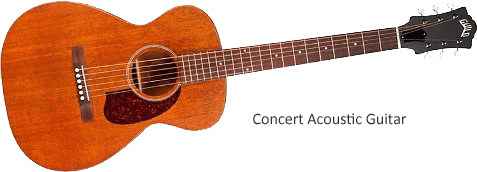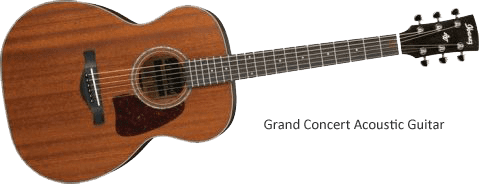Maybe you're an experienced player, ready to upgrade to a better guitar. In that case, it is important to know the difference between various tonewoods and how the soundboard affects resonance.
Construction & Design
Purpose
Skill Level
Body Style
Neck Width & Length
Nylon vs Steel Strings
Styles & Sound
Tops - Solid vs Laminate
Tone Woods
Perssonal Preference
Construction & Design

Once you understand the basics about how an acoustic guitar is designed and built, you will be able to see and hear subtle differences that will help you choose the best guitar for your needs.
Body Style
There are about as many nuances to the style of an acoustic guitar body as there are companies that create them. It is important to make sure that you choose a guitar that will produce the sound you want, but also one that is comfortable for you to play whether you are sitting or standing.
The sound board is the top portion of the body of the guitar. In general, the larger the soundboard, the deeper and louder the sound. Other styles combine a large soundboard with a narrow waist to make the guitar more comfortable.
Popular acoustic guitar body shapes include:
Concert Acoustic Guitar

Their smaller size, generally about 13-1/2" at the lower bout, give them a bright sound with a punchy mid-range. The smaller size is comfortable, and makes these guitars very playable for smaller musicians.
Grand Concert Acoustic Guitar

Grand Concert body styles are just a bit larger, generally at about 14 to 14-1/4" at the lower bout. They still boast a good mid-range, but with a stronger sound.
Auditorium & Grand Auditorium Acoustic Guitar

The Auditorium style is a standard mid-sized acoustic guitar, with a lower bout that is generally the same width as a dreadnought, but with a smaller waist. Sometimes referred to as an "orchestra" body, these guitars balance volume, tone, and comfort, and have been regaining popular ground in recent decades.
The Grand Auditorium's lower bout is sometimes wider than the classic dreadnought's - generally 16" - but the waist is narrower, creating a dramatic hourglass shape. These guitars have a greater range for volume and more balanced tone than smaller body styles.
Dreadnought Acoustic Guitar

A common acoustic body style that makes use of a very large soundboard is the dreadnought. Dreadnoughts are distinctive for their square bouts, wide waists, and 14-fret necks. The first dreadnought was developed in 1916, and it has been gaining in popularity ever since. Dreadnoughts are very popular among bluegrass guitarists due to their powerful, driving sound.
Jumbo Acoustic Guitar (with cutaway)

These big, boomy guitars are often considered the standard "cowboy" guitars. Up to 17" at the lower bout, these acoustic guitars project loudly and resonate deeply.
Some acoustic guitars, regardless of the body style, feature a "cutaway" in the upper bout to allow players to more easily reach the higher frets on the guitar neck. If you plan to play leads on your acoustic, or are used to playing an electric guitar, you may prefer a guitar body with a cutaway.
Small - Mini Travel Acoustic Guitar

Smaller players, musicians who travel frequently, and parents shopping for children, may also want to consider travel and mini-acoustic guitars. These guitars were designed for the comfort of smaller players, and for convenience when traveling, but many guitar manufacturers have invested significant time and resources into creating smaller-scale acoustic guitars that don't compromise quality or sound.
Most utilize the same familiar shape of a standard acoustic guitar, at about 3/4-scale, with 18 to 20 frets. Others, often referred to as "backpackers," have a narrow body that only fans out slightly from the width of the neck. Backpackers are designed to be durable, lightweight, and easy to pack.
Neck Width & Length
The thickness and width of guitar necks vary, depending on the size of the guitar body. It will not affect the sound of the guitar, but it will affect your comfort with the instrument.
Acoustic necks are usually listed as 12- or 14-fret necks. This number refers to the number of frets above the guitar body, not the total number of frets. On a 12-fret neck, the 13th and 14th frets will be on the body, and, thus, harder to reach than on a 14-fret neck, where they are extended beyond the guitar body. If you have small hands, look for an acoustic guitar with a smaller diameter neck.
Nylon vs Steel Strings
It's a common misconception that beginners should start with nylon strings because they're gentler on the fingers or easier to play. However, nylon and steel strings are not interchangeable on the same guitar, so it's not about progressing from one type to the other as you gain experience. Instead, your choice should be guided by the type of music you wish to play.
Nylon strings produce a softer, mellow tone. They are often used in classical and flamenco-style guitar playing, as well as some folk music. Classical guitars have a wider neck to provide more space between the strings, and shorter fretboard, than acoustic guitars that use steel strings.
Steel strings are more common, and are usually used by rock, country and pop musicians. Steel string acoustic guitars create a louder, brighter tone that is commonly associated with that classic acoustic guitar sound.
Styles & Sound
While all acoustic guitars share the same basic construction and design elements, there are important differences that affect their sound and playability. Each guitar shares those basic characteristics above, but now that you know how an acoustic guitar is designed and built, you will want to consider some of the variables that change how each guitar feels and plays. These variables include:
- Body styles
- Tops
- Neck width and length
- Nylon vs. steel strings
- Tonewood
Tops - Solid vs Laminate
The top of the guitar plays a crucial role in determining the instrument's tone quality. The vibrations from the guitar strings are transferred through the bridge to the top, where they are amplified. As explained in the Tonewoods section, the type of wood used for the top significantly affects the guitar's tonal characteristics. Therefore, as previously noted, a larger soundboard results in a larger sound.
Acoustic guitar tops are made of either solid wood, or laminate. A solid top is usually made of two, single-ply pieces of wood with their grains matched down the middle of the guitar top. A laminate top is made of several layers of wood - usually a more high-grade one on top, and several generic ones beneath - pressed together.
Laminate does not vibrate as well as solid wood does, so it does not produce as rich a sound or as great a volume. It is, however, an excellent option for beginners, to save money on a first acoustic guitar.
Tone Woods
As you shop, you will notice a variety of woods specified on different parts of acoustic guitars. Being able to identify the sound you want from your guitar will help you choose. Here is an overview of some common woods, how they are used, and their tonal characteristics they are known for:
Cedar » Cedar is a soft wood that produces a bright tone. It has a quick response that favors a light playing technique, and is a common top wood for classical or flamenco guitars. It is also used for sides and backs.
Cocobolo » Cocobolo is a tropical, Mexican hardwood used for sides and backs. It is fast, responsive and produces a bright sound.
Ebony » Ebony is strong with a slick feel, which makes it great fretboard material.
Granadillo » Granadillo is a scarce wood, considered a type of rosewood, though it is denser. It is traditionally used for marimba bars, and when used for the sides and backs of acoustic guitars, produces a similar clear, ringing tone.
Koa » Koa is a Hawaiian wood with a distinct golden color that emphasizes mid-range tones. It is used for all parts of an acoustic guitar body, but is generally found on more expensive guitars due to its scarcity.
Mahogany » Mahogany is a dense wood, which gives it a slower response rate. When used as a top wood, mahogany produces a strong sound that emphasizes high-end tones, and is often associated with country or blues playing.
It is more often used for sides and backs to add snap, boost mid-range tones, and reduces boominess in some styles. It is also frequently used in necks and bridges.
Maple » Maple is commonly utilized for the sides and backs of instruments due to its low response rate and internal damping, which prevents it from adding coloration to the natural tone of the top wood. It generates a “dry” sound that highlights high-end tones. Its reduced resonance makes it ideal for live performances, especially with a band, as it can cut through a mix of instruments with minimal feedback.
Ovangkol » Ovangkol is a sustainable African wood similar to rosewood. It is usually used for back and sides, because its warm tone emphasizes mid-tones and produces a well-rounded sound. Ovangkol's tone offers the warmth of rosewood with the sparkling midrange of mahogany or koa.
Rosewood » The decreasing availability of Brazilian Rosewood has resulted in Indian Rosewood becoming its substitute in most markets. Despite their different appearances, both types offer similar tonal qualities. Rosewood, a favored and traditional choice for acoustic guitars, is highly valued for its rich and complex overtones, which remain clear even in bass-heavy passages. Its sharp attack and resonant tones provide a highly articulate sound with excellent projection. Additionally, rosewood is commonly used for fingerboards and bridges.
Sapele » Sapele is another highly sustainable African wood, used for sides and backs to add midrange and additional resonance. Tonally similar to mahogany, it offers a little more treble boost.
Spruce » Spruce is a standard for acoustic guitar tops. It is lightweight but strong, and provides good resonance without compromising clarity. There are many species of spruce used in guitar tops including Sitka, Engelmann, Adirondack, and European spruce. They each have subtly distinct tonal characteristics and colors.
Walnut » Walnut is an alternative to mahogany in bodies, emphasizing midrange tones and enhancing the projection of the top wood's tone. It has a similar density and stiffness to koa, with similarly bright high-end tones. Its low-end tones start deeper, but fill out after being played-in.
Personal Preference
Finally, as you contemplate tops, shapes, and tones, come prepared with clear expectations. Know how you intend to use your guitar and have a basic understanding of how acoustic guitars function, including how different woods and components influence their sound. Ultimately, regardless of the features or price, the guitar that matches your style will be the one you cherish for years to come.



